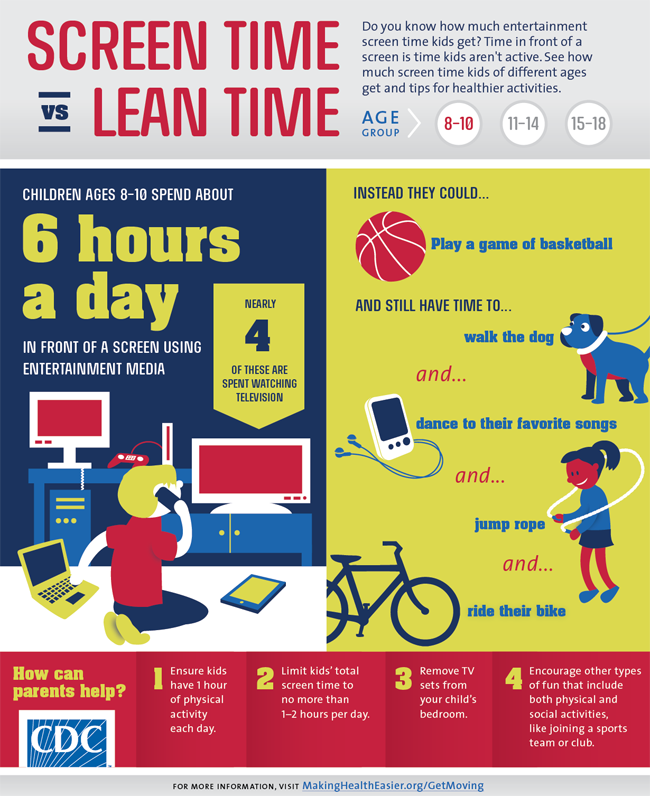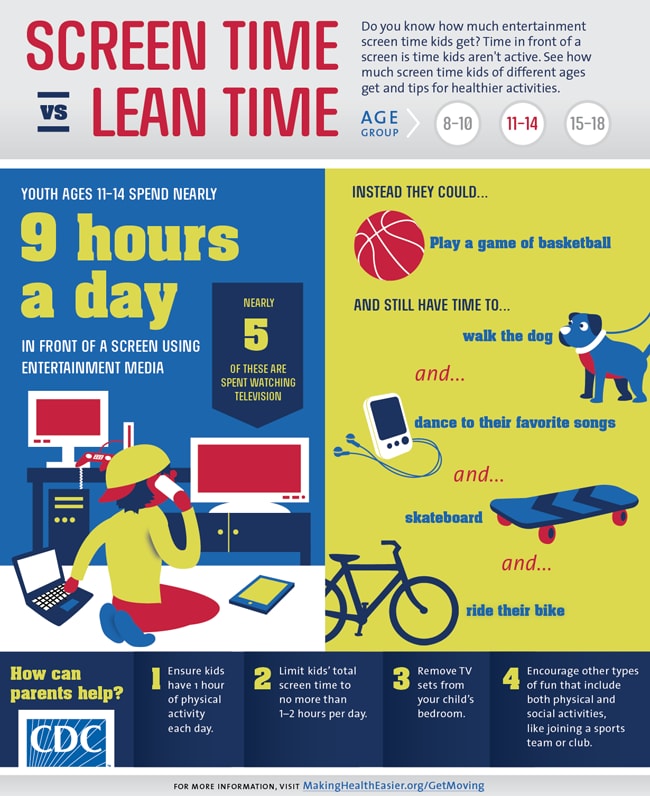Why is Screen Time Important for Teens?
In today’s digital age, screens have become a ubiquitous presence in our daily lives, and it has become increasingly important for teenagers. Screen time refers to the amount of time spent on digital devices such as smartphones, tablets, laptops, and televisions. While excessive screen time has been linked to negative health effects, moderate use can have several benefits for teenagers. Let’s have a look on what average screen time for teens looks like.
1/ Average Screen Time for Teens
Current trends and statistics
According to a survey conducted in 2019 by Common Sense Media, American tweens aged between 8 to 12 years old spent an average of 4.4 hours per day on digital devices, excluding school-related work. This means that teens spent more than one-third of their day in front of screens.
With COVID, figures reached an all time high of at least 6 hours of screen time per day for the same group, according to CDC (Infographic 1).
A research, which was released in JAMA Pediatrics, found that teens’ screen use outside of virtual school increased from pre-pandemic (before COVID) estimates of 3.8 hours per day to 7.7 hours.
Another study by Pew Research Center found that 95% of teens have access to smartphones, and 45% say they are online almost constantly.

Source: CDC (infographic 1)
Factors Affecting Screen Time
Several factors affect the amount of time teens spend on screens:
- One of the main factors is the availability of digital devices. As digital devices become more affordable and accessible, teenagers are more likely to spend more time on them.
- Another factor is social media, which has become a significant part of the lives of most teenagers. Social media platforms such as Instagram, Snapchat, and TikTok are highly addictive and can consume a considerable amount of time. Peer pressure is also a significant factor that affects the amount of time teens spend on screens. Teenagers feel the need to fit in and keep up with their peers, and spending time on screens is one way to achieve this.
2/ Health Risks Associated with Excessive Screen Time
Excessive screen time can lead to various health risks, including physical, mental, and behavioral health issues. Let’s discuss the health risks associated with excessive screen time, categorized into physical, mental, and behavioral health risks.
Physical Health Risks
Excessive screen time can have a significant impact on physical health. Studies have shown that prolonged screen time can lead to:
- poor posture,
- eye strain
- headaches
- neck and back pain
Furthermore, excessive screen time can lead to a sedentary lifestyle, which can increase:
- the risk of obesity
- cardiovascular disease
- diabetes
According to a study published in the Journal of the American Medical Association, children who spend more than two hours a day in front of screens have a higher risk of developing obesity than those who spend less than two hours a day.
Mental Health Risks
Excessive screen time can also have a detrimental effect on mental health. Studies have shown that excessive screen time is associated with an increased risk of anxiety, depression, and other mental health issues.
According to a study published in the journal BMC Public Health, teenagers who spend more than five hours a day in front of screens are more likely to experience symptoms of depression and anxiety than those who spend less than an hour a day in front of screens.
Behavioral Risks
Excessive screen time can also lead to various behavioral issues. Studies have shown that excessive screen time can affect sleep patterns, leading to sleep deprivation and insomnia.
Moreover, excessive screen time can lead to a lack of social skills and poor communication skills. Children and teenagers who spend more time in front of screens are less likely to engage in physical activities, which can lead to a lack of social skills and poor communication skills.
3/ Setting Healthy Limits for Screen Time
Guidelines for Parents and Guardians
The American Academy of Pediatrics recommends that children between the ages of 2 and 5 years old should have no more than one hour of screen time per day, while children aged 6 and above should have consistent limits that ensure adequate time for physical activity, sleep, and social interactions.
Parents and guardians should be aware of the content their children are watching and ensure that it is appropriate for their age and developmental stage.
Additionally, it is crucial to model healthy screen habits and limit their own screen time to set a positive example for their children.

Infographic 2
Strategies to Reduce Screen Time
Reducing screen time can be a challenge, especially when screens are such an integral part of our daily lives. However, there are several strategies parents and guardians can use to help their children cut back on screen time.
- One of the most effective strategies is to create alternative activities that are engaging and enjoyable, such as outdoor play, reading, or board games.
- It is also important to establish screen-free zones in the house, such as during meals or in bedrooms, and to set specific times for screen use, such as after completing homework or chores.
- Additionally, parents and guardians can work with their children to create a screen time schedule, allowing them to have some control over their screen use while still adhering to established limits.
4/ Promoting a Balanced Lifestyle for Teens
As a parent or guardian, it is vital to encourage and promote a balanced lifestyle for teens. In this day and age, it is easy for teens to become engrossed in technology and spend a lot of time indoors.
As we discussed earlier, this sedentary lifestyle can lead to numerous health problems.
Let’s see how some alternative activities for teens and the importance of exercise outdoor activities can help in promoting a balanced lifestyle.
Alternative Activities for Teens
- Encourage Reading: Reading is a great way for teens to relax and unwind. It is also a fantastic way to broaden their horizons and learn new things.
- Arts and Crafts: Arts and crafts are a fun way for teens to express themselves creatively. It is also a good way to develop their fine motor skills.
- Board Games: Board games are a great way to spend time with family and friends. It is also a good way to develop critical thinking and problem-solving skills.
- Volunteering: Volunteering is a great way for teens to give back to their community. It is also a good way to develop a sense of empathy and responsibility.
Importance of Exercise and Outdoor Activities
Exercise and outdoor activities are essential for teens’ physical and mental well-being. Here are some reasons why:
- Physical Health: Exercise helps in maintaining a healthy weight, strengthens the heart and lungs, and reduces the risk of chronic diseases.
- Mental Health: Outdoor activities have been shown to reduce stress, anxiety, and depression. Exercise also releases endorphins, which can boost mood and increase feelings of happiness.
- Social Interaction: Participating in outdoor activities and team sports can help teens develop social skills and make new friends.
- Cognitive Development: Exercise has been shown to improve cognitive function, memory, and attention span
Conclusion
Recap of Key Points
Screen time has become an integral part of teenagers’ daily lives.
While excessive screen time can lead to various health risks, moderate screen use can be beneficial for teenagers.
The availability of digital devices, social media, and peer pressure are some of the factors that influence screen time.
Excessive screen time can lead to physical, mental, and behavioral health issues, such as poor posture, eye strain, headaches, anxiety, and lack of social skills.
Therefore, setting healthy limits for screen time is crucial, and parents and guardians must model healthy screen habits.
Strategies such as creating alternative activities and establishing screen-free zones in the house can help reduce screen time.
Encouraging a balanced lifestyle that includes exercise and outdoor activities is essential for promoting teenagers’ well-being.
Overall, it is essential to recognize the potential benefits and risks of screen time and strive for a healthy balance.
Final Thoughts and Recommendations
Our recommendations for average screen time for teenagers:
- Follow guidelines from reputable organizations: The American Academy of Pediatrics recommends that children aged 6 and above should have consistent limits that ensure adequate time for physical activity, sleep, and social interactions. Parents and guardians should follow these guidelines and set limits accordingly.
- Set realistic and achievable limits: Parents and guardians should work with their teens to set realistic limits on screen time that take into account their daily routines, schoolwork, and other activities. Setting unrealistic limits can lead to frustration and noncompliance.
- Encourage physical activity: Teens should be encouraged to engage in physical activity such as sports or outdoor activities to break up their screen time and maintain a healthy lifestyle.
- Promote alternative activities: Parents and guardians should encourage their teens to engage in alternative activities such as reading, arts and crafts, or board games that do not involve screens.
- Monitor content: It is important for parents and guardians to monitor the content their teens are accessing on screens to ensure it is appropriate for their age and developmental stage.
- Lead by example: Parents and guardians should model healthy screen habits and limit their own screen time to set a positive example for their teens.
Remember, the goal is not to completely eliminate screen time but to find a healthy balance that allows for a well-rounded lifestyle.

Source: CDC, Age group 8-10 (Infographic 3)

Source: CDC, Age group 11-14 (Infographic 4)
Sources:
1) COMMON SENSE MEDIA:
https://www.commonsensemedia.org/kids-action/articles/tweens-teens-and-phones-what-our-2019-research-reveals
2) JAMANETWORK: https://jamanetwork.com/journals/jamapediatrics/fullarticle/2785686
3) PEW RESEARCH CENTER:
https://www.geekwire.com/2018/new-research-finds-95-teens-access-smartphone-45-online-almost-constantly/#:~:text=Pew%20reports%20that%2095%20percent%20of%20teens%20can,and%20ethnicities%20and%20socioeconomic%20backgrounds%2C%E2%80%9D%20the%20report%20said.
4) CENTERS FOR PREVENTION AN DISEASE CONTROL (CDC): Infographic 1
4) BMC PUBLIC HEALTH:
https://bmcpublichealth.biomedcentral.com/articles/10.1186/s12889-020-09429-3
The American Academy of Pediatrics: https://www.apa.org/monitor/2020/04/cover-kids-screens#:~:text=AAP%20calls%20for%20no%20screen%20time%20at%20all,children%20negotiate%20limits%20and%20boundaries%20around%20screen%20usage.
5) AMERICAN ACADEMY OF CHILD AND ADOLESCENT PSYCHIATRY: Infographic 2
6) CDC: Infographic 3 and 4